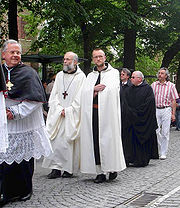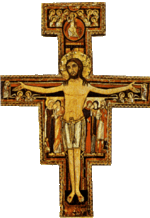Trappists


The Order of Cistercians of the Strict Observance (O.C.S.O.: Ordo Cisterciensis Strictioris Observantiae), or Trappists, are a Roman Catholic religious order of contemplative monks who follow the Rule of St. Benedict.
The Trappists are a branch of the Cistercians, and like the other Cistercian orders they also have a women's branch commonly referred to as the Trappistines.
The Trappist monks of the Tre Fontane (Three Fountains) Abbey raise the lambs whose wool is used to make the pallia of new metropolitan archbishops that are presented by the Pope to them on the Solemnity of Saints Peter and Paul, the Holy Apostles; they are blessed by the Pope on the Feast of Saint Agnes, January 21.
Contents |
History
The order takes the name of "Trappist" from La Trappe Abbey or "La Grande Trappe" in Normandy in France, where it began as a reform movement in 1664, in reaction to the relaxation of practices in many Cistercian monasteries[1]. The reform was led by Armand Jean le Bouthillier de Rancé, originally the commendatory abbot of La Trappe. As commendatory abbot, de Rancé was a layman who obtained income from the monastery but had no religious obligations. After a conversion of life between 1660 and 1662, de Rancé formally joined the abbey and became its regular abbot in 1663[2]. In 1892 the reformed "Trappists" broke out of the cistercian order and formed an independent monastic order with the approval of the pope[3].
Monastic life
The life of the Trappists is guided by the Rule of St. Benedict, written in the sixth century. The Rule describes ideals and values of a monastic life.
"Strict Observance" refers to the Trappists' aim at following closely St. Benedict's Rule, and take the three vows described in his Rule (c. 58): stability, fidelity to monastic life, and obedience. As Benedict also insisted on silence, it has some importance in their way of life. However, contrary to popular belief,they do not take a vow of silence.[4] Trappist monks will generally only speak when necessary, and idle talk is strongly discouraged. In years past, a Trappist Sign Language, distinct from other forms of monastic sign language, was developed to dissuade speaking. Meals are usually taken in contemplative silence, as members of the order are supposed to listen to a reading [5]. Trappists' silence should be understood as the wish to give space to what matters: gaining a deeper love and understanding of God.
The Trappists have received greater attention in recent years because of the popularity of the writings of Thomas Merton and, more recently, because of the popularity of Trappist ales such as Chimay, Westmalle, and a select few others.
Goods for sale
The 48th chapter of the Rule of St. Benedict states "for then are they monks in truth, if they live by the work of their hands" [6]
Following this rule, most Trappist monasteries produce goods that are then sold to provide an income for the monastery. The goods produced can range from cheese, bread and other foodstuffs to clothing and coffins. As the order does not require abstention from alcohol, some monasteries produce and sell alcoholic beverages. Some monasteries in Belgium and the Netherlands, such as Orval Abbey and Westvleteren Abbey, brew beer both for the monks and for sale to the general public. Trappist beers contain residual sugars and living yeast, and, as bottle-conditioned beers do [7] , will improve with age.[8] These have become quite famous and are considered by many beer critics to be amongst the finest in the world.[8]
Monasteries
Currently there are nearly 170 Trappist monasteries in the world, the home of approximately 2,100 Trappist monks and 1,800 Trappist nuns.[9]
Locations
- Monasterio Trapense Nuestra Señora de los Ángeles, near Azul, Buenos Aires
- Tarrawarra Abbey, Victoria, Australia
- Abtei Engelszell, Engelhartszell, Upper Austria
- Scourmont Abbey, (Chimay)
- Orval Abbey, Florenville
- Rochefort Abbey, Rochefort
- Westmalle Abbey, Westmalle
- Westvleteren Abbey, Westvleteren
- Achel Abbey, Achel
- Priory of Our Lady of Klaarland (Bocholt)
- Marija Zvijezda (Maria Stern) near Banja Luka
- Our Lady of New World, near Campo do Tenente, Paraná Official site
- Abbey of Notre-Dame du Lac, Oka, Quebec
- Monastère Notre-Dame de Mistassini, Dolbeau-Mistassini, Quebec
- Notre-Dame de l'Assomption Abbey, Rogersville, New Brunswick
- Notre Dame du Calvaire Abbey, Rogersville, New Brunswick
- Our Lady of the Prairies, Holland, Manitoba
- Monastery of St. Mary of Miraflores, Rancagua
- Monasterio Nuestra Señora de Quilvo (Trappistine nuns), Curico
- Nový Dvůr near Toužim
- Monasterio Santa María del Evangelio, Jarabacoa
- Cîteaux Abbey
- Abbaye Notre-Dame d'Oelenberg, Alsace
- Our Lady of the Snows (Ardèche) ("Notre-Dame-des-Neiges")
- Our Lady Port of Salvation, in Entrammes (Mayenne) Official site
- Our Lady of Bonneval (Aveyron) (Trappistine nuns) Official website
- Sept-Fons Abbey at Diou in Bourbonnais in the diocese of Moulins in France.
- Mariawald Abbey, Heimbach (Eifel)
- Caldey Abbey, Caldey Island, off Tenby, Dyfed
- Holy Cross Abbey, Whitland, South Wales
- Mount St. Bernard Abbey, Coalville, Leicestershire
- Sancta Maria Abbey, Nunraw, Haddington, East Lothian
- Our Lady of Joy Abbey (Trappist Haven Monastery), on Lantau Island
- Temanggung known as Pertapaan Trapis Rawaseneng (Central Java, about 50 kilometers south-west Semarang, Central Java)
- Bolton Abbey, Moone, Athy, County Kildare
- Mellifont Abbey, Collon, County Louth, oldest cistercian house in Ireland est.c.1142
- Mount Melleray Abbey, Cappoquin, County Waterford
- Mount St. Joseph Abbey, Roscrea, County Tipperary
- Our Lady of Bethlehem, Portglenone, Ballymena, County Antrim
- St. Mary's Abbey, Glencairn, Lismore, County Waterford
- Latrun (about 15 kilometers west of Jerusalem)
- Rome, Abbazia delle Tre Fontane, Abbazia delle Tre Fontane
- Hiji, Hayami District, Ōita Prefecture
- Kamiiso, Hokkaidō
- Nishinomiya
- Abdij Koningshoeven, Berkel-Enschot
- Abdij Koningsoord, Berkel-Enschot
- Abdij Sion, Diepenveen
- Abdij Maria Toevlucht, Zundert
- Abdij Lilbosch, Echt
- Abdij O.L. Vrouw Onbevlekt Ontvangen, Tegelen
- Southern Star Abbey, Kopua, Hawkes Bay
- Our Lady of the Philippines Trappist Monastery, Jordan, Guimaras
- monks
-
- San Isidro de Dueñas Monastery
- Santa María la Real de Oseira Monastery
- Abbey of Santa María de Viaceli
- San Pedro de Cardeña Monastery
- Priory of Cenarruza
- Santa María de la Oliva
- Santa María de las Escalonias Monastery
- nuns
-
- Santa María Gratia Dei Monastery
- Monastery of Alloz
- Our Lady of Vico Monastery
- Santa María la Real Monastery
- Santa Ana Monastery
- Santa María de Carrizo Monastery
- Our Lady of Charity Monastery
- Our Lady of Peace Monastery
- Monastery of Armenteira
- Our Lady of the Holy Spirit Monastery in Conyers, Georgia.
- Abbey of New Clairvaux, near Vina, California
- New Melleray Abbey, near Dubuque, Iowa
- Our Lady of the Mississippi Abbey (Trappistine nuns), Dubuque, Iowa
- Abbey of Gethsemani near Bardstown, Kentucky (where Thomas Merton lived)
- St. Joseph's Abbey, Spencer, Massachusetts
- Mount Saint Mary's Abbey (Trappistine nuns), Wrentham, Massachusetts
- Abbey of the Genesee, Piffard, New York
- Assumption Abbey, Ava, Missouri
- Our Lady of Guadalupe Trappist Abbey, Lafayette, Oregon
- Mepkin Abbey, Moncks Corner, South Carolina
- Abbey of Our Lady of the Holy Trinity [1], Huntsville, Utah
- Holy Cross Abbey, near Berryville, Virginia
- St. Benedict's Monastery, Snowmass, Colorado
- Monastery of Our Lady of the Angels (Trappistine nuns), Crozet, VA
- Monasterio Trapense Nuestra Señora de los Andes, Official website, Mérida
See also
- Cistercians: history of the Order
- Cistercian Martyrs of Atlas
References
- ↑ Pennington, M. Basil, OCSO. "The Cistercians: An Introductory History". The Order of Saint Benedict. http://www.osb.org/cist/intro.html. Retrieved 2008-01-01.
- ↑ CATHOLIC ENCYCLOPEDIA: Jean-Armand Le Bouthillier de Rance
- ↑ History of the Cistercian Order in Europe
- ↑ FAQ-eng
- ↑ Rule of St. Benedict, c. 38: Reading must not be wanting at the table of the brethren when they are eating. The 1949 Edition Translated by Rev. Boniface Verheyen, OSB.
- ↑ Rule of Benedict, Chapter 48. From the 1949 Edition. Translated by Rev. Boniface Verheyen, O.S.B., of St. Benedict's Abbey, Atchison, Kansas.
- ↑ CAMRA bottled beer guide, 6th edition
- ↑ 8.0 8.1 Michael Jackson's Beer Hunter - Chastity, poverty and a pint
- ↑ FAQ-eng
External links
|
|||||||
